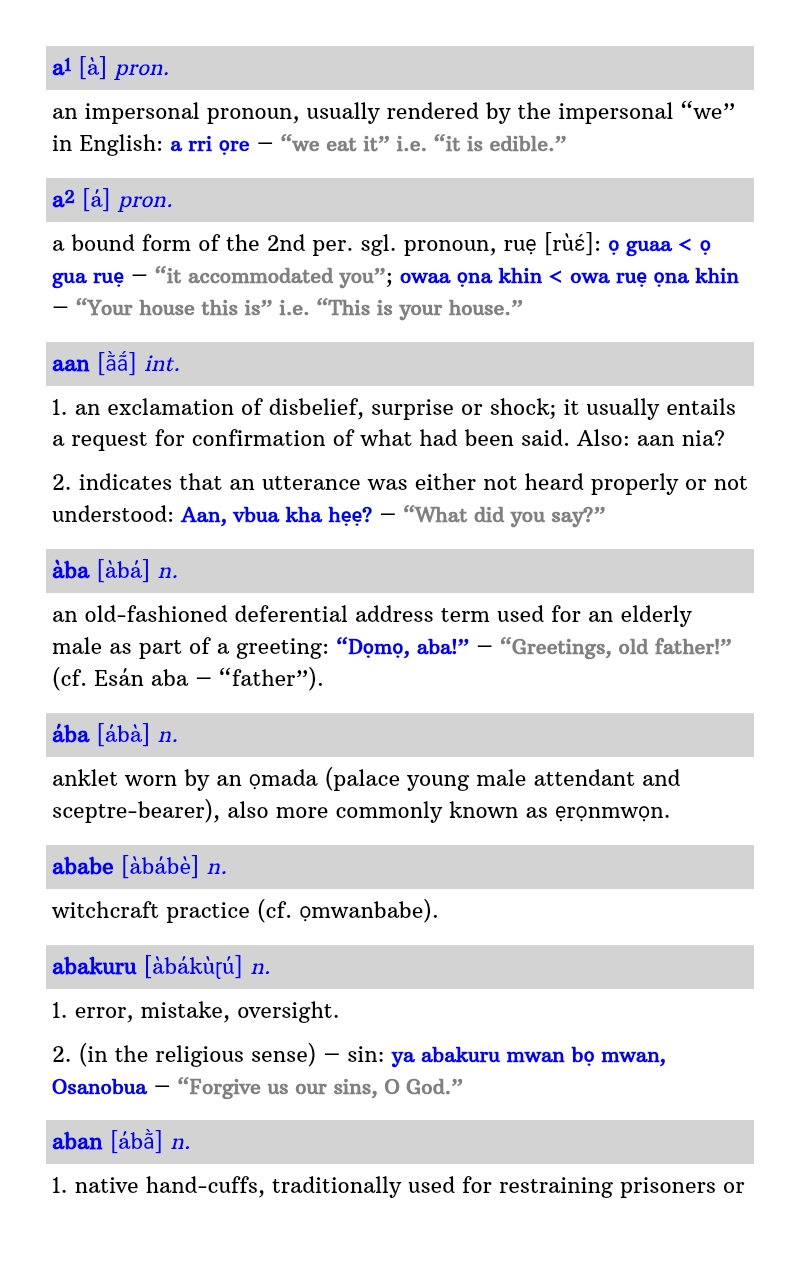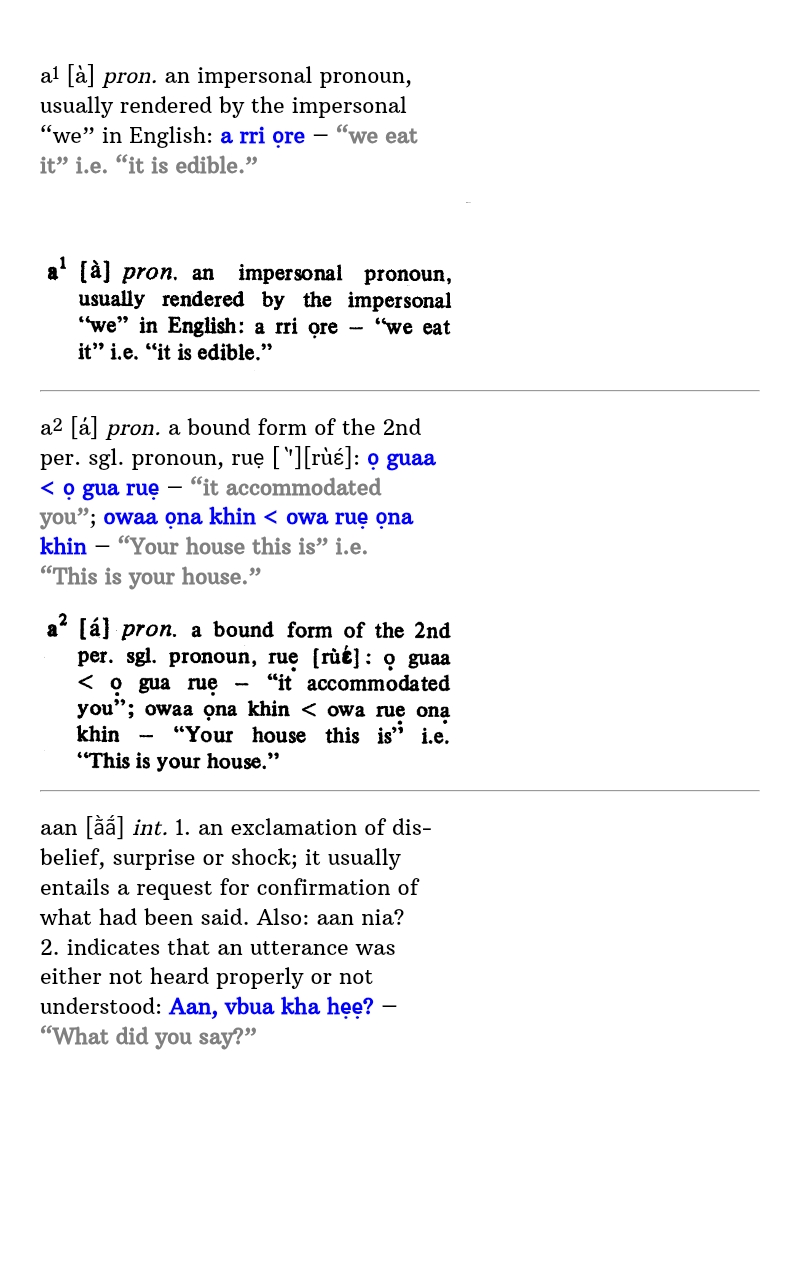
This epub book contains a digital version of Rebecca Agheyisi's book:
An epub book is a zip-file containing html-files and other files organized in a standard way. This zip-file can be unzipped with any zip-program (after renaming the 'epub' extension to 'zip', if necessary) to access files that may not be accessible through the epub reader.
The epub file contains the masterfile from which the other formats have been generated. In addition there is a light version of the dictionary (1.0 MB) that contains only the digitized dictionary without the scanned text.
Edo (Bini) is the language spoken in and around Benin City in Southern Nigeria. The first Edo-English dictionary is:
Another Edo-English dictionary has recently been published:
There are no English-Edo or monolingual Edo dictionaries. Only an English-Edo wordlist based on Melzian's dictionary has been published:
Agheyisi's book contains the following parts:
In the digital version, front matter and pages i-xxiv have been put into one html-page. The dictionary itself has been organized as one html-page for each letter of the Edo alphabet.
The dictionary entries have been reformatted using some heuristic rules as shown in the following picture (Lithium epub reader):

The grey area for an entry word is a link to the column in the book containing the entry as shown in the following picture:

Each digitized entry is followed by a scan of the original text. This digitized entry is identical to the text in the previous picture except for words that have been hyphenated at the end of a column line (ex. 'dis-belief' and 'disbelief' in the third entry). Both texts have been generated from a common masterfile which contains the dictionary entries in a 'raw' format. Showing the digitized text together with the scanned text allows to easily verify the digitized text.
The dictionary contains a number of special characters. These have been encoded using UTF-8 UNICODE.
Not all readers display the special characters in the dictionary correctly. The following table lists all special characters in the dictionary:
The correct display is:
̀ and ́ are tonal markers. The first indicates low tone, the second high tone. Tonal markers appear on vowels. The low tone marker also appears on some consonants:
̃ marks nasality. It normaly appears on vowels but sometimes also on consonants. It can be combined with tonal markers.
The letters ẹ, ọ, gh, mw and vb of the Edo alphabet are phonetically represented by resp. ɛ, ɔ, ɣ, ɱ and ʋ.
The three r-sounds, the letters r, rh and rr are phonetically represented by resp. ɽ, ř and r.
g͡ and k͡ are combined with b and p to give g͡b and k͡p. The letters gb en kp are usually written as g͡b and k͡p in the phonetics of an Edo word but not always.
The phonetic characters ɔ̌, c̀, ě, û, ɽ̌, ỹ́ and ỹ̀ appear resp.
Obazee does not put a tone marker on the ɔ and Melzian gives a rising tone. The c̀ should clearly be ɔ̀. obveni means 'elephant trunk'. Obazee gives óvbè and óvbén (no final i) for 'trunk of an elephant'. Melzian gives resp. a falling, a rising and a low tone for the ě. Obazee writes ùkpẹ́ and similarly Melzian gives a low tone for the u and a high tone for the ẹ. The ɽ̌ is clearly a mistake and should be ř. The ỹ́ and ỹ̀ are examples of excessive use of diacritical markers.
As to the ẏ character, in fourteen cases y has what seems like a dot on top of it. The relevant entries are: inia [ínẏá], irhiaeni [ìřẏàenì], irriabe [ìrẏàbè], irriokodẹ [irẏòkòdɛ̀], iziengbe [ìzẏẽ̀g͡bè], miọghọọn [mẏɔ̃̀ɣɔ̃̀ɔ̃̀], okhiẹ1 [òxẏɛ́], orriamugho [órẏámúɣò], orriara1 [òrẏàɽà], ọgiodẹ [ɔ̀gẏòdɛ̀], ọrriegie [ɔ̀rẏègẏè], ọrriọvbe [ɔ̀rẏɔ̀ʋè], sẹrhiẹnrhiẹn [sɛ̀řyɛ̃̀řẏɛ̃́].
Even in those cases where the dot is a clear dot it does not always appear in the middle. As the meaning of the ẏ is not explained by Agheyisi these 'dots' are probably typographical errors. Therefore the digital dictionary uses y instead of ẏ in these fourteen cases.